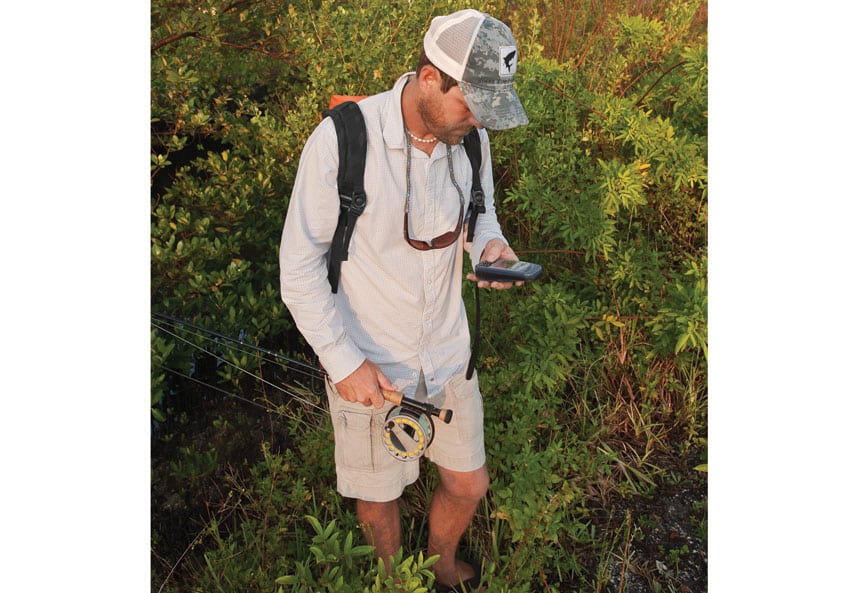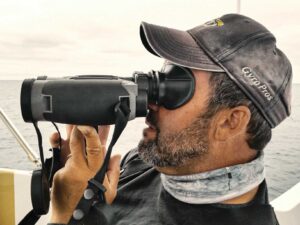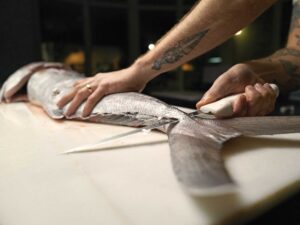
The idea of a GPS, for shorebound fishing always seemed like overcomplicating an endeavor I reserved for simplicity. With the cell phone already turned off, the question remained: Why would I want to be encumbered with yet another electronic gadget?
It was a night on Joppa Flats, in Massachusetts, that got me thinking. I’d managed to get myself turned around on an incoming tide, and as I walked up the launch ramp that night with my hands above my head, holding my rod and car keys to keep them dry, I realized how lucky I was. Another 10 minutes likely would have meant swimming to that launch ramp rather than walking in water up to my elbows.
I sat in my car for a long while, thankful to be safe and berating myself for my foolishness as I looked out onto the flats where I easily could have drowned. But this was how I was choosing to fish: on the flats on moonless nights, when the striped bass would come in to chow down. How could I fish this area and prevent myself from being in the same predicament again? The very next day, I plunked down the cash for a handheld GPS.
How Fishermen Can Use a Handheld GPS
It took me a while to get the hang of the basic functions. A long afternoon in a local park brought me up to speed on the tools I needed to know so I could avoid my past folly. I learned how to track my path, place points on the map, track back through those points and even calculate distance traveled over time. A few days later, I was out on the flats again, tracking and retracing a safe path for me to return to the car. After a few trips, I started thinking to myself, “What else can I do with this thing?”
A basic sunrise and sunset tool, as well as a moon-phase utility, were preprogrammed. A tide utility, with predictions based on your location and not a nearby buoy, gave me much more accurate results than I had ever expected.
The first major task I set forth to accomplish was to add locations I had not visited previously but had only heard or read about. Although I tend to fish in a few general areas from the surf, there always seem to be spots in between that might be worth checking out. With the GPS, I was able to add these places for nights when the bite is slow and I am feeling adventurous. I was also able to add comments about the places, as well as where I could park and not be towed.
I then was able to flesh out the area even further by adding to the maps overlays of deeper water and channels from existing global maps that I managed to find on the internet. While this information is also available from most GPS makers, it can be an expensive add-on. In a short span of time, I was able to add an incredible amount of information about spots I hadn’t previously fished. While this is no substitute for learning the water and real experience, it softened the learning curve dramatically.
A Handheld GPS is Multitask Tool
Shortly after my purchase, during a lengthy shorebound weekend trip, I realized I could use the GPS as a perfect fishing log. By adding waypoints to the unit when fish were caught, I could later pinpoint what the tide stage, water temperature, wind speed and direction, barometric pressure and other elements were, all easily found online using the time stamp.
Advanced GPS units now have the capability to take photos. While the photo quality will not rival that of a good digital camera, the basic notion is that images are another layer of information that can be utilized. When casting from the surf, I’m inclined to cycle through anywhere from three styles of flies to a dozen different offerings in different colors. This visual documentation of what worked gives me a more accurate means to state what caught fish. The pictures provide times and geographical coordinates, allowing me to nail down some very specific facts.
While it may seem pretty easy to remember what worked the next day or the week after, I know that when I sit down at my tying desk to prepare flies for the coming season, I always wish I had better notes. In the past, after a successful outing, I would take the effective fly out of rotation and jot down notes about the place and conditions. While this meant I had great notes for tying and the next season, it also meant I was removing a proven fish-catching fly from my box.
With the camera in the GPS, all potential X factors are removed, and I can duplicate flies that worked and know when and where they worked. It also allows me to expand upon the design of the flies and create offerings that could potentially be more successful in the future. There’s no greater confidence I can have than stepping onto the beach with a box full of flies that I know are proven fish catchers.
I don’t see a GPS as a replacement for a notebook fishing log, but I do strongly believe that both have their place for shorebound fly-anglers. Considering the accuracy and tools available in a handheld GPS, it seems shortsighted not to give yourself the distinct advantages that no other device can offer.
Research What Handheld GPS You Want
Not all handheld GPS devices are created equal. Take the time to look for a unit that is waterproof and shockproof. While it’s unlikely you will need it to stay underwater for hours on end, it should be able to handle being splashed and bounced around on a carabiner attached to your pack or jacket.
Units designed for automotive use aren’t up to the task and aren’t intended for the sort of abuse that surf-casting and hiking can dish out. The good news is that some handheld units come equipped with or can have maps added to them for use on the road.
Invest in a good set of rechargeable batteries and a small waterproof case. Most handheld GPS units have excellent battery life and will last an entire day of fishing on one charge. But if you find the batteries have run down, you’ll be glad you had a set of spares on hand.
And before you hit the water, take the time to learn how the unit works. Not all GPS devices are user-friendly, and some functions can be baffling to figure out. Learn the basics in a controlled environment before you have to count on them potentially to save your life.









